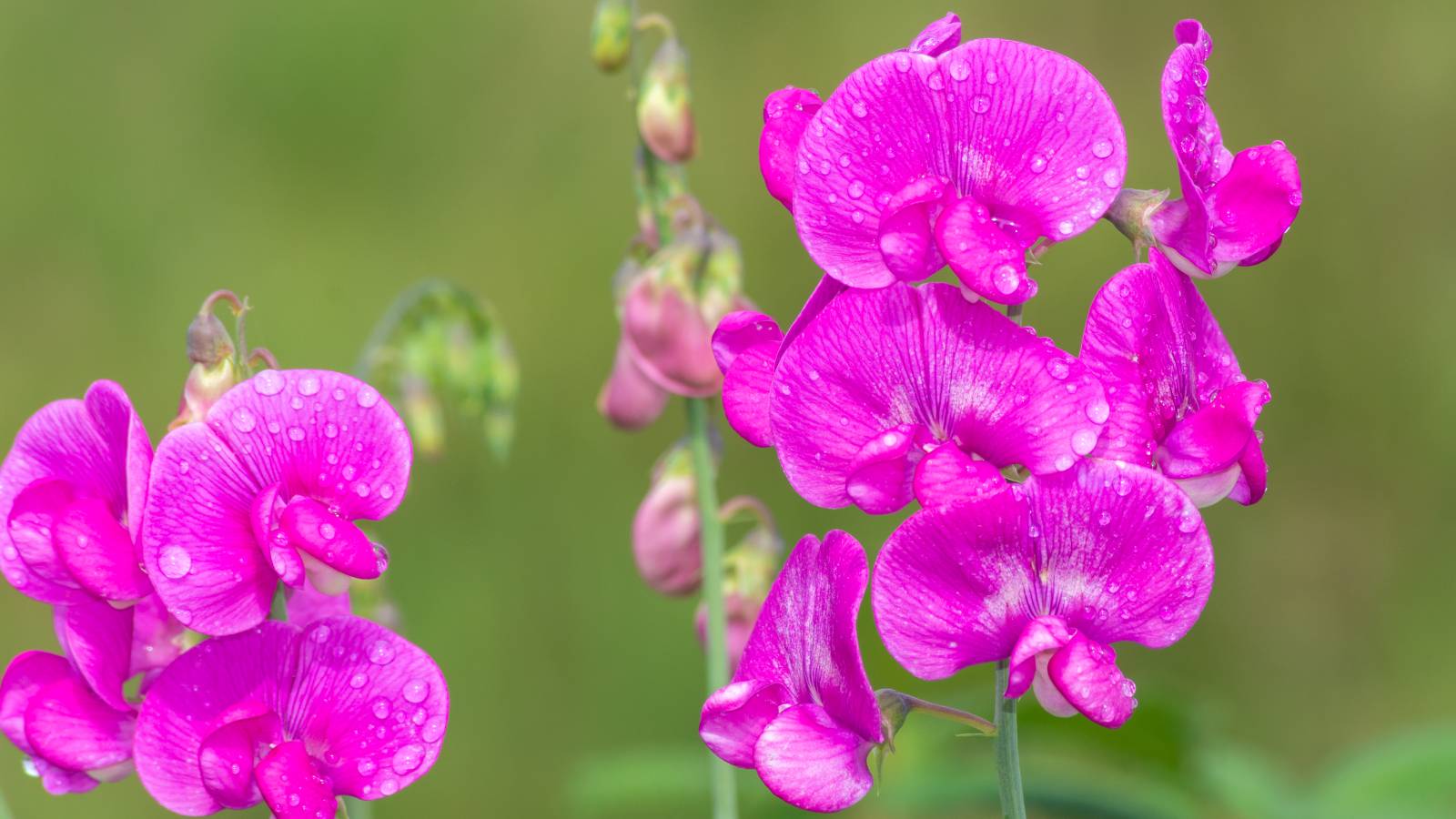Perennial Sweet Pea (Lathyrus Latifolius) Care: How To Grow These Whimsical Vines
No need to replant Lathyrus latifolius! Perennial sweet peas' beautiful pink blooms will come back in spring year after year.

Quick Facts
Botanical name: Lathyrus latifolius
Height: 6-10 feet (2-3 m)
Spread: 6 feet (2 m)
Sun exposure: Full sun
Soil requirements: Average, well-draining
Hardiness zones: 3-8
When to plant: Early spring
Many gardeners know and love sweet peas, the aromatic annual vines that bloom in a variety of colors. But there is also a perennial sweet pea vine with just as much charm, plus the added benefit of flowers that return each year.
Lathyrus latifolius, also referred to as everlasting sweet pea, looks right at home in a cottage garden, climbing up a trellis, or draped over a picket fence. Not only does this vine has eye-catching magenta blooms, but it's also an easy alternative to growing sweet peas since you only have to plant them once.
Interested in growing your own everlasting pea vine for years of whimsical summer blooms? Read on to learn all about this old-fashioned favorite.
Perennial Sweet Pea Basics
Perennial sweet pea (Lathyrus latifolius) is an herbaceous climbing vine that has been widely cultivated in North America since the early 1700’s. Over time it has naturalized through most of the United States and Canada and can be found along roads, railroads, fields, fences, and other disturbed areas. It is deer resistant.
The plant has paired leaflets along a vine that either climbs support structures or rambles along the ground. The showy blossoms bloom in the early summer to fall (June through late September) in hues of rose, pinkish-purple or white. Unlike annual sweet peas, the blooms are not fragrant, however they do attract hummingbirds, butterflies and beneficial pollinators. Post bloom, the vine is covered with flat, pea-like seed pods.
Also known as wild sweet pea, this perennial spreads via underground rhizomes or self sows to an extent that it can be termed invasive. The seeds of this species are toxic to some extent.
Perennial Sweet Pea Care
Everlasting sweet pea is an easy to grow vine that has graced home gardens for centuries. Properly cared for, this is a long-lasting perennial perfect for covering hillsides, unsightly structures, or fencing.
Gardening tips, videos, info and more delivered right to your inbox!
Sign up for the Gardening Know How newsletter today and receive a free copy of our e-book "How to Grow Delicious Tomatoes".
Light
Perennial sweet peas prefer full sun exposure but can be grown in partial sun. For the best blooms, grow in a location that receives at least 6 to 8 hours of sunlight each day.
Water
Everlasting sweet peas are somewhat drought tolerant, though they prefer deep watering 2-3 times per week depending upon weather conditions. Use a soaker hose or drip irrigation to prevent fungal disease.
Temperature & Humidity
Perennial sweet peas prefer cool summer climates with temperatures that do not fall below 50 F (10 C) at night. While the plant enjoys consistently moist soil, there is no need for additional humidity. Everlasting sweet peas can be grown in USDA zones 3-8.
Soil
Sweet peas can grow in almost any soil however they thrive in soil that is rich in organic matter. The soil should also be well-draining. This vine is indifferent to pH levels as well as clay, sand, or loam soils.
Fertilizer
Fertilizer is unnecessary, provided the plant was provided soil rich with organic matter at the time of planting. Once the sweet pea plant is established, avoid the use of nitrogen rich fertilizer. Instead, opt for a fertilizer high in potash.
Amend the soil annually as needed with aged manure and compost.
How to Plant Perennial Sweet Peas
Everlasting sweet peas propagate by self-sowing or via rhizomes. Seeds are hard, so they either need to be nicked with a toenail clipper, rubbed with an emery board or soaked in water prior to sowing.
Dig a hole a foot away from whatever support the sweet peas will be using. Sow the seeds when soil temperatures are above 50 F (10 C). Sow seeds a couple of inches (5 cm) apart. Water the seeds well.
Keep the soil moist, but not sodden. Seeds should germinate in 3-4 days. Thin the seeds to about a foot (30 cm) apart.
Pruning Perennial Sweet Pea Plants
Deadhead the sweet pea vine as flowers wane to facilitate additional blooms. Also snip seed pods at this time to encourage blooming over seed production.
Pruning is used to prevent sweet peas from getting out of control and to encourage bushy growth. Use your thumb and forefinger to pinch sweet peas for fuller plants that produce more blooms.
In the fall or early spring, cut the plant back to ground level and remove any dead or cut vine from the trellis or support.
Problems, Pests & Diseases
Generally perennial sweet peas are a low maintenance plant with few problems. If it is too crowded or overwatered, it is prone to fungal diseases and pests such as snails and slugs.
Fungal issues related to sweet peas include black root rot, gray mold, leaf spot, mildew, and rust.
Note: Perennial sweet peas are toxic.
Perennial Sweet Pea Varieties
Cultivars to look for include Albus, Blushing Bride, Pink Beauty, Pink Pearl, Snow Queen and Splendens.
Is Perennial Sweet Pea Invasive?
Yes, perennial sweet peas have the potential to be invasive. They readily self-sow and are spread through underground rhizomes.
Grow the Cottage Garden of Your Dreams
- Dive into the cottage garden trend and get inspired by these essential cottage garden ideas.
- These cottage garden plants add romantic charm to any landscape and are absolute musts for a true English cottage style garden.
- Explore more vines in the Gardening Know How Shop that look lovely climbing up a trellis or cascading over an arbor.
- Garden in style with beautiful (and durable) gloves from Womanswork. Both you and your garden will be Insta ready and #swoonworthy
This article features products available from third party vendors on the Gardening Know How Shop.

Amy Grant has been gardening for 30 years and writing for 15. A professional chef and caterer, Amy's area of expertise is culinary gardening.
-
 Looking For Plants To Give You The Soft And Fuzzies? Try These 5 Fuzzy Leaf Plant Options
Looking For Plants To Give You The Soft And Fuzzies? Try These 5 Fuzzy Leaf Plant OptionsLovers of texture, drama, silver foliage and tactile plants will adore these special sensory garden additions. These fuzzy leaf plant options will leave you all aglow
By Susan Albert
-
 Get Ready For A Summer Of Hummers! Grow These Full Sun Hummingbird Plants and Flowers
Get Ready For A Summer Of Hummers! Grow These Full Sun Hummingbird Plants and FlowersIf you’re lucky enough to enjoy a sunny backyard, make sure you are maxing out on your pollinator opportunities and grow these full sun hummingbird plants and flowers
By Tonya Barnett